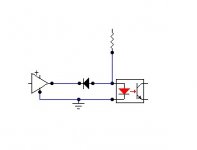Hi, Ionutgaga,
Maybe its better for you to look at FFT. Scope capture in small time/div don't reveal hiss/noise (unless the scope's time/div is big)
Maybe its better for you to look at FFT. Scope capture in small time/div don't reveal hiss/noise (unless the scope's time/div is big)
The triangle is huge with +/-2.5V.
So you modulator is probaly quite forgiving.
As reference: In my breadboard proto the comparator output has less than 5ns jitter with +/-340mV input triangle, nevertheless I can hear noise when I go about 15cm close to the tweeter.
I would not expect your comparator/modulator to be the noise source, but you never know...
To search the jitter you need to look the ns-range.
Witch 0.5us/grid even a heavily jittered edge will still look like a sharp edge.
But how about 50ns/grid?
Again my proposal:
Use chanel 1 to watch and trigger to the comparator output. Use chanel 2 to watch any other point in the circuit at the same time. With this you can easily watch down to several tens of ns. Furtheron this will give you
a detailed information about your propagation delays.
So you modulator is probaly quite forgiving.
As reference: In my breadboard proto the comparator output has less than 5ns jitter with +/-340mV input triangle, nevertheless I can hear noise when I go about 15cm close to the tweeter.
I would not expect your comparator/modulator to be the noise source, but you never know...
To search the jitter you need to look the ns-range.
Witch 0.5us/grid even a heavily jittered edge will still look like a sharp edge.
But how about 50ns/grid?
Again my proposal:
Use chanel 1 to watch and trigger to the comparator output. Use chanel 2 to watch any other point in the circuit at the same time. With this you can easily watch down to several tens of ns. Furtheron this will give you
a detailed information about your propagation delays.
So... it is not from 6N137 opto....
My old oscilloscope did not have dual ch, and minimum time div is 200ns. Thanks ChocoHolic for your advices. Status for classD project: maybe stopped...
My old oscilloscope did not have dual ch, and minimum time div is 200ns. Thanks ChocoHolic for your advices. Status for classD project: maybe stopped...
yes Workhorse ,but since we dont know the real cause,everything in circuit has to be checked in order to catch any change in hiss pattern and maybe have some light.
Interesting that Crown ,Powersoft and other companies are not using 6n137 on power stage of pwm amplifier.
Interesting that Crown ,Powersoft and other companies are not using 6n137 on power stage of pwm amplifier.
odnaizutra said:yes Workhorse ,but since we dont know the real cause,everything in circuit has to be checked in order to catch any change in hiss pattern and maybe have some light.
Interesting that Crown ,Powersoft and other companies are not using 6n137 on power stage of pwm amplifier.
Fredos, D-amp uses 6N137!!!!
Yes,Fredos uses this component for a long time and he is not in problems...
Have you increased the gate resistors just to see if fast switching is not interfering any thing before the optocoupler?
If a function generator is placed instead of modulator?
Have you increased the gate resistors just to see if fast switching is not interfering any thing before the optocoupler?
If a function generator is placed instead of modulator?
I use 6N137 with TC4429 for many years without probleme, even with 74A 200V APT devices...But large dead time before 6N137, done with GAL device ( some logic are done before too...).. Maybe look at your output coil, try some Sendust or -2 from micro metal...Or it's just supply contamination trought the ground. Change the orientation of output coil too...
Fredos
Fredos
I experienced noise too. Optocouplers are basically very noisy, in amplitude domain. If driving pulse transition is not fast enough, then amplitude is converted to time. Waveforming (+1 CMOS inverter before LED) solved the problem in my case.
Driving the led in shunt mode solves the problem.
What do you mean?
What do you mean?
Have a look
Attachments
- Status
- Not open for further replies.
- Home
- Amplifiers
- Class D
- optocoupling power stage - hiss with 6N137
